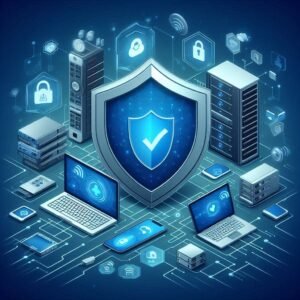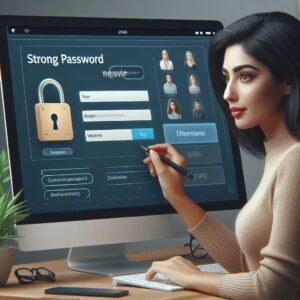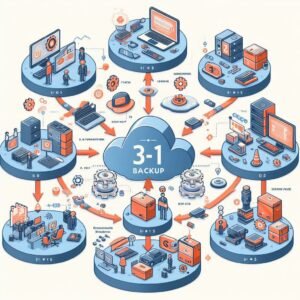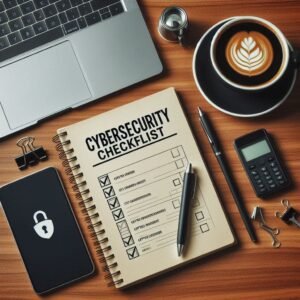Cybersecurity Best Practices
A Complete Guide for Individuals and Businesses

Cybersecurity isn’t just a concern for IT professionals anymore. It’s a daily priority for anyone who uses the internet. Whether you’re managing a personal smartphone or running a company with hundreds of employees, protecting your digital life is non negotiable.
Let me break down what actually matters, how to stay ahead of threats, and what smart habits you need to adopt right now.
Why Cybersecurity Best Practices Matter
Most cyberattacks don’t happen because of complex zero day exploits. They succeed because someone clicked a bad link or reused the same password everywhere. That’s it.
Hackers aren’t always chasing billion dollar corporations. They go after the easiest targets, and poor habits make you easy prey.
Let’s look at the essentials that actually move the needle.
1. Use Strong, Unique Passwords for Every Account
A weak password is like leaving your door unlocked and hoping no one tries it. Even worse is using the same key for every door.
What works:
-
Use at least 12 characters
-
Combine upper and lowercase letters, numbers, and symbols
-
Avoid dictionary words and personal info
-
Use a password manager to store and generate passwords
Avoid:
-
Birthdays, pet names, or “123456”
-
Reusing the same password across platforms

2. Enable Two Factor Authentication (2FA)
Even with a strong password, there’s still a risk. Two factor authentication adds an extra layer by requiring something you know (password) and something you have (your phone or security key).
What to use:
-
Authenticator apps like Google Authenticator or Authy
-
Hardware tokens like YubiKey
-
Avoid SMS when possible due to SIM swap risks
This one simple step can stop over 90 percent of account takeovers.
3. Keep Your Software Updated
Software updates are often ignored, but they exist for a reason. Many of them patch security holes that hackers already know about.
Always update:
-
Operating systems (Windows, macOS, iOS, Android)
-
Web browsers
-
Antivirus and antimalware programs
-
Any app or plugin you use regularly

4. Beware of Phishing Attempts
Phishing attacks trick you into giving up sensitive info. They often look like legitimate emails from banks, coworkers, or well known services.
Red flags:
-
Urgent language like “Act now or your account will be suspended”
-
Suspicious links (hover to preview the URL)
-
Attachments from unknown senders
-
Spelling mistakes and generic greetings
What to do:
-
Don’t click on links or download attachments blindly
-
Verify the source by calling the company directly
-
Report phishing to your email provider
5. Use a Secure Internet Connection
Public Wi-Fi is convenient, but it’s a security risk if you’re not careful.
If you must use it:
-
Never access sensitive accounts on public networks
-
Use a virtual private network (VPN) to encrypt your connection
-
Avoid online shopping or banking unless you’re on a trusted network
6. Back Up Your Data Regularly
Backups are your insurance policy against ransomware, hardware failures, or accidental deletion.
Follow the 3 2 1 rule:
-
Keep three copies of your data
-
Use two different types of storage (cloud and local)
-
Store one backup off site
Automate backups when possible, and test them periodically.

7. Educate Yourself and Your Team
Security isn’t just a technical issue it is a human one. Most breaches happen because someone did not know better.
If you run a business, train your employees. If you’re a solo user, stay informed.
Best practices:
-
Conduct regular cybersecurity training
-
Simulate phishing tests
-
Set clear policies for password management and device use
Remember: You can’t fix what you don’t understand.
8. Limit Access Based on Roles
Not everyone needs access to everything. The more people who can touch sensitive data, the greater the risk.
Use role based access:
-
Give users only the permissions they need
-
Regularly review who has access
-
Revoke access immediately when someone leaves
This reduces insider threats and helps contain breaches.
9. Monitor Your Accounts and Systems
You can’t protect what you don’t monitor. Catching suspicious activity early can prevent a full blown incident.
What to watch:
-
Unusual login attempts
-
Devices connecting from unknown locations
-
Sudden spikes in bandwidth usage
-
Unapproved software installations
Tools to consider:
-
Security information and event management (SIEM) systems
-
Activity logs in cloud accounts
-
Alerts from antivirus or endpoint detection systems
10. Don’t Ignore Mobile Devices
Phones and tablets carry just as much risk as laptops. Sometimes more.
Protect them like computers:
-
Use biometrics and strong passcodes
-
Install apps only from trusted sources
-
Keep the operating system up to date
-
Enable remote wipe in case the device is lost or stolen
11. Be Smart with Social Media
What you post online can be used against you. Cybercriminals use personal info to guess passwords, answer security questions, or craft targeted phishing attacks.
Think before you post:
-
Don’t overshare personal milestones, travel plans, or work details
-
Lock down your privacy settings
-
Avoid location tagging in real time
12. Dispose of Devices Securely
Before you toss out or sell your old phone, laptop, or hard drive, wipe it properly.
Steps to follow:
-
Backup your data
-
Perform a full factory reset
-
Use secure erase tools for hard drives
-
Physically destroy drives if they’re no longer needed
Don’t just delete files. Make sure nothing can be recovered.

Final Thoughts
Cybersecurity isn’t about being paranoid. It’s about being prepared. Most of what matters comes down to habits: strong passwords, critical thinking, regular updates, and backups.
Whether you’re managing personal data or company infrastructure, these practices can prevent the majority of attacks you’ll face.
Take them seriously, apply them consistently, and stay one step ahead.
Quick Recap: Cybersecurity Best Practices Checklist
-
Use strong, unique passwords
-
Enable two factor authentication
-
Keep all software updated
-
Watch out for phishing emails
-
Avoid public Wi-Fi without a VPN
-
Back up your data regularly
-
Educate yourself and others
-
Restrict access based on roles
-
Monitor your systems
-
Secure your mobile devices
-
Be cautious on social media
-
Properly wipe old devices

Please check out below some important articles

Pingback: साइबर सुरक्षा के सबसे ज़रूरी तरीके